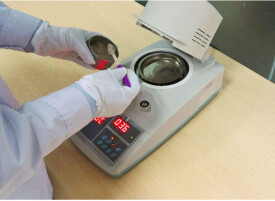乾燥失重
乾燥失重
乾燥失重,指待測物品在規定的條件下,經乾燥至恆重后所減少的重量,通常以百分率表示。
系指藥物在規定的條件下,經乾燥至恆重后所減失的重量,通常以百分率表示。
本法適用於受熱穩定及水分易趕除的藥物。將供試品置已在相同條件下乾燥至恆重的扁形稱量瓶內,精密稱定,於烘箱內在規定溫度下乾燥至桓重。“恆重”是指供試品連續兩次乾燥或熾灼后的重量差異在0.3mg以下的重量。乾燥至恆重的第二次以及以後各次稱重均應在規定條件下繼續乾燥1小時後進行。乾燥溫度一般為105℃。有的藥物含結晶水,在105℃水分不易除去,可提高於燥溫度,如枸櫞酸鈉含結晶水,要求在180℃乾燥至恆重。為了使水分及揮發性物質易於揮散,供試品應平鋪於扁形稱量瓶中,其厚度不超過5mm,如為疏鬆物質,厚度不超過10mm。如為大顆粒結晶,應研細至粒度約2mm。放入烘箱進行乾燥時,應將瓶蓋取下,置稱量瓶旁,或將瓶蓋半開進行乾燥。取出時,須先將瓶蓋蓋好,置乾燥器中放冷至室溫,然後稱定重量。某些藥物中含有較大量的水分,熔點又較低,如直接在105℃乾燥,供試品即熔化,表面結成一層薄膜,使水分不易繼續揮發。此類藥物應先在低溫下乾燥,使大部分水分除去后,再於規定溫度乾燥至恆重。如測定硫代硫酸鈉的乾燥失重,需先在40~50℃乾燥,然後漸次升溫,最後於105℃烘至恆重。
本法適用於受熱易分解或揮發的藥物。供試品置乾燥器內,利用器內貯放的乾燥劑、吸收供試品中的水分,乾燥至恆重。常用的乾燥劑有硅膠、硫酸和五氧化二磷等。其中五氧化二磷的吸水效力、吸水容量和吸水速度均較好,但價格較貴。在使用時將其鋪於培養皿中,置乾燥器內,如發現表層已結塊或出現液滴,即需更換。硫酸的吸水效力與吸水速度次於五氧化二磷,但吸水容量比五氧化二磷大,價格也較便宜。使用時應盛於培養皿或燒杯中,不能直接傾入乾燥器,搬動乾燥器時,應注意勿使硫酸濺至稱量瓶或供試品上。用過的硫酸,經加熱除去水分后可再用。硅膠吸水效力也次於五氧化二磷,但大於硫酸,且使用方便,價廉。變色硅膠1g吸水約20mg開始變色,在105℃乾燥后可再使用。
本法適用於熔點低,受熱不穩定及水分難趕除的藥物。減壓乾燥法是指在減壓下乾燥的方法。在減壓條件下,可降低乾燥溫度和縮短乾燥時間。有的藥物熔點低,或對熱不穩定不能加熱,可在減壓乾燥器中採用減壓下乾燥劑乾燥的方法。如布洛芬熔點為74.5~77.5℃,規定在五氧化二磷乾燥器中減壓乾燥至恆重。腎上腺素規定在五氧化二磷乾燥器個減壓乾燥18小時。能耐受一定溫度的樣品,可採用減壓下加熱乾燥的方法。如地高辛規定在105℃減壓乾燥1小時。減壓下加熱乾燥時使用恆溫減壓乾燥箱。採用減壓乾燥器或恆溫減壓乾燥箱時,除另有規定外,壓力應在2.67kPa(20mmHg)以下。
R927.1
cnki:ISSN:1007-306X.0.2004-03-029
幾乎是化學原料葯的必測項目。其準確的測定與否影響著化學結構的判斷和含量測定的結果。含結晶水藥物的水分(或含結晶溶劑時溶劑)測定,是結構確定的一個很重要因素;同一化合物含不同的結晶水往往會視為不同的藥物。那種數據不夠水分湊,用隨意的加××%吸附水,以改變計算值,使之與理論值相符是不科學的、也是不可取的。嚴格的測定含結晶水的方法,首選晶體X 射線衍射(SXRD)。晶體X衍射是很繁瑣的工作,單晶的培養、測試、計算工作量都很大,一般並不常做。用常規的四大波譜(IR、UV、NMR、MS)進行結構確證。
<731> LOSS ON DRYING
The procedure set forth in this chapter determines the amount of volatile matter of any kind that is driven off under the conditions specified. For substances appearing to contain water as the only volatile constituent, the procedure given in the chapter, Water Determination 921 , is appropriate, and is specified in the individual monograph.
Mix and accurately weigh the substance to be tested, and, unless otherwise directed in the individual monograph, conduct the determination on 1 to 2 g. If the test specimen is in the form of large crystals, reduce the particle size to about 2 mm by quickly crushing. Tare a glass-stoppered, shallow weighing bottle that has been dried for 30 minutes under the same conditions to be employed in the determination. Put the test specimen in the bottle, replace the cover, and accurately weigh the bottle and the contents. By gentle, sidewise shaking, distribute the test specimen as evenly as practicable to a depth of about 5 mm generally, and not more than 10 mm in the case of bulky materials. Place the loaded bottle in the drying chamber, removing the stopper and leaving it also in the chamber. Dry the test specimen at the temperature and for the time specified in the monograph. [NOTE—The temperature specified in the monograph is to be regarded as being within the range of ±2 of the stated figure.] Upon opening the chamber, close the bottle promptly, and allow it to come to room temperature in a desiccator before weighing.
If the substance melts at a lower temperature than that specified for the determination of Loss on drying, maintain the bottle with its contents for 1 to 2 hours at a temperature 5 to 10 below the melting temperature, then dry at the specified temperature.
Where the specimen under test is Capsules, use a portion of the mixed contents of not fewer than 4 capsules.
Where the specimen under test is Tablets, use powder from not fewer than 4 tablets ground to a fine powder.
Where the individual monograph directs that loss on drying be determined by thermogravimetric analysis, a sensitive electrobalance is to be used.
Where drying in vacuum over a desiccant is directed in the individual monograph, a vacuum desiccator or a vacuum drying pistol, or other suitable vacuum drying apparatus, is to be used.
Where drying in a desiccator is specified, exercise particular care to ensure that the desiccant is kept fully effective by frequent replacement.
Where drying in a capillary-stoppered bottle* in vacuum is directed in the individual monograph, use a bottle or tube fitted with a stopper having a 225 ± 25 µm diameter capillary, and maintain the heating chamber at a pressure of 5 mm or less of mercury. At the end of the heating period, admit dry air to the heating chamber, remove the bottle, and with the capillary stopper still in place allow it to cool in a desiccator before weighing.
本章中給出的方法闡述了在特定的條件下物質中的揮發性成分的測定。對於水分為唯一揮發性成分的物質,按各論中規定的<921>水分測定法測定。
除各論中另有規定外,取混勻后(如果樣品是比較大的結晶,應先迅速搗碎使成2mm左右的顆粒)的待測樣品,精密稱定1-2克置於與樣品相同條件下乾燥30分鐘的具塞扁形稱量瓶中,稱量瓶先稱取皮重,待樣品加入后,蓋上瓶蓋,稱取總重。輕輕地平移振搖,儘可能使樣品均勻平鋪成約5mm厚,對於比較鬆散的、體積大的也不應超過10mm厚。將裝有樣品的稱量瓶放在乾燥室內,瓶蓋打開,也放入乾燥室,按各論中規定的溫度和時間乾燥。[注意:各論中規定的乾燥溫度應該被視為規定溫度±2℃。]打開乾燥室,立即蓋上瓶蓋,移入乾燥器中冷卻到室溫,然後稱量。
當待測樣品未達到規定的乾燥溫度時就融化時,應先在低於上述融化溫度5-10℃下乾燥1-2小時,然後在規定溫度下乾燥。
假如樣品是膠囊,應至少取4粒膠囊的內容物,混勻后取樣。
假如樣品是片劑,應至少取4片,研細混勻后取樣。
假如各論中要求採用熱重分析法測定乾燥失重,需要用到高精度電子天平。
假如各論中要求真空乾燥,需要用到真空乾燥器、真空乾燥槍或者其他真空乾燥設備。
當用到乾燥器時,應該特別注意及時更換乾燥劑以保持其有效狀態。
假如各論中要求採用毛細管塞稱量瓶測定乾燥失重,應該使用直徑為225±25um的毛細管塞稱量瓶,毛細管塞放在乾燥器中,裝有樣品的稱量瓶按規定乾燥,維持乾燥室內的壓力在5毫米汞柱或者更低。在加熱結束時,可以把乾燥的空氣放進乾燥室內,取出稱量瓶,移入乾燥器,蓋上毛細管塞,冷卻,稱重。
乾燥失重=(W1-W2)/W1*100%。
W1為乾燥前的樣品重量,
W2為乾燥后的樣品重量。
W1-W2就是乾燥中減失的重量。
